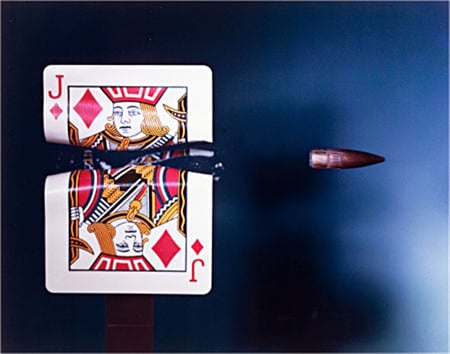
Harold Edgerton, Milk Drop Coronet, 1957
In 1931, as a graduate student at MIT, Edgerton combined the camera with the stroboscope, a device invented in 1831 for studying objects in motion. Edgerton’s device, which formed the basis for the development of the modern electric flash, emitted a series of high-speed bursts of light from electrically controlled neon tubes that could record on film a series of stopped-action sequential images. These extremely short flashes of light overcame the mechanical restrictions of the camera shutter, illuminating events or portions of events as brief as one three-millionth of a second in duration. This invention, states Edgerton, allowed “time itself to be chopped up into small bits and frozen so that it suits our needs and wished.”1
Harold Edgerton, Diver, 1958
“Don’t make me out to be an artist,” stated Edgerton. “I am an engineer. I am after the facts. Only the facts.”2 It is the startling beauty of these facts discovered by Edgerton that astonishes us. Using his improved stroboscope, he could photograph motion as a single image, or in multiples of up to 600 per second. Linked to a motion picture camera, this device would produce greatly improved slow motion film footage.
Harold Edgerton, Bullet Piercing an Apple, 1964
The images Edgerton created celebrate the union of art and science: the crown of droplets created by a splash of milk, the perfect geometric patterns formed by a somersaulting diver before he slices into the water, a speeding bullet frozen in space as it explodes through an apple, and a football caving in from the impact of an athlete’s foot. These images all reveal the harmony and logic of natural laws, the invisible symmetry of everyday phenomena.
Harold Edgerton, Football Kick, 1938